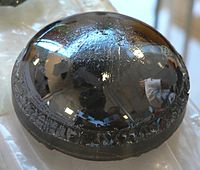
Photo from wikipedia
Developing methods and approaches for preserving water relations, plant growth and productivity are essential under water deficit conditions. New nano-silicon complexes were synthesized (glycine nano-silicon, glutamine nano-silicon and histidine nano-silicon)… Click to show full abstract
Developing methods and approaches for preserving water relations, plant growth and productivity are essential under water deficit conditions. New nano-silicon complexes were synthesized (glycine nano-silicon, glutamine nano-silicon and histidine nano-silicon) to evaluate their foliar application in different concentrations (0, 1.5 and 3.0 mM) on growth, essential oil yield, water relations, and mineral composition of field grown feverfew (Tanacetum parthenium L.) under drought. Drought stress was imposed by different irrigation intervals (4, 8 and 12 days). By increasing irrigation interval, leaf relative water content and leaf water potential were declined which decreased biomass, leaf area, flower formation, essential oil production and health of the plant. Potassium and organic osmolytes accumulation under moderate drought stress alleviated the adverse effects water deficit condition. This was mainly due to proline and potassium accumulation in the plants’ leaves. Although accumulation of soluble carbohydrates also was observed in the drought stressed plants, it was found to be a passive response to plant growth inhibition under drought. Moreover, drought stress decreased plant phosphorous content, but had no significant effect on plant nitrogen content. Foliar application of nano-silicon by improving the plant’s water content and phosphorus absorption, recovered the plants’ health and growth under moderate and severe drought conditions. In this regard, no significant differences were observed between 1.5 and 3.0 mM nano-silicon treatments. However, glycine nano-silicon treated plants represented higher drought tolerance (higher dry mass, leaf area, number and greenness) than the other complexes. Accordingly, foliar application of 1.5 mM glycine nano silicon for mitigating adverse effects of drought stress on feverfew was recommended.
Journal Title: Silicon
Year Published: 2020
Link to full text (if available)
Share on Social Media: Sign Up to like & get
recommendations!